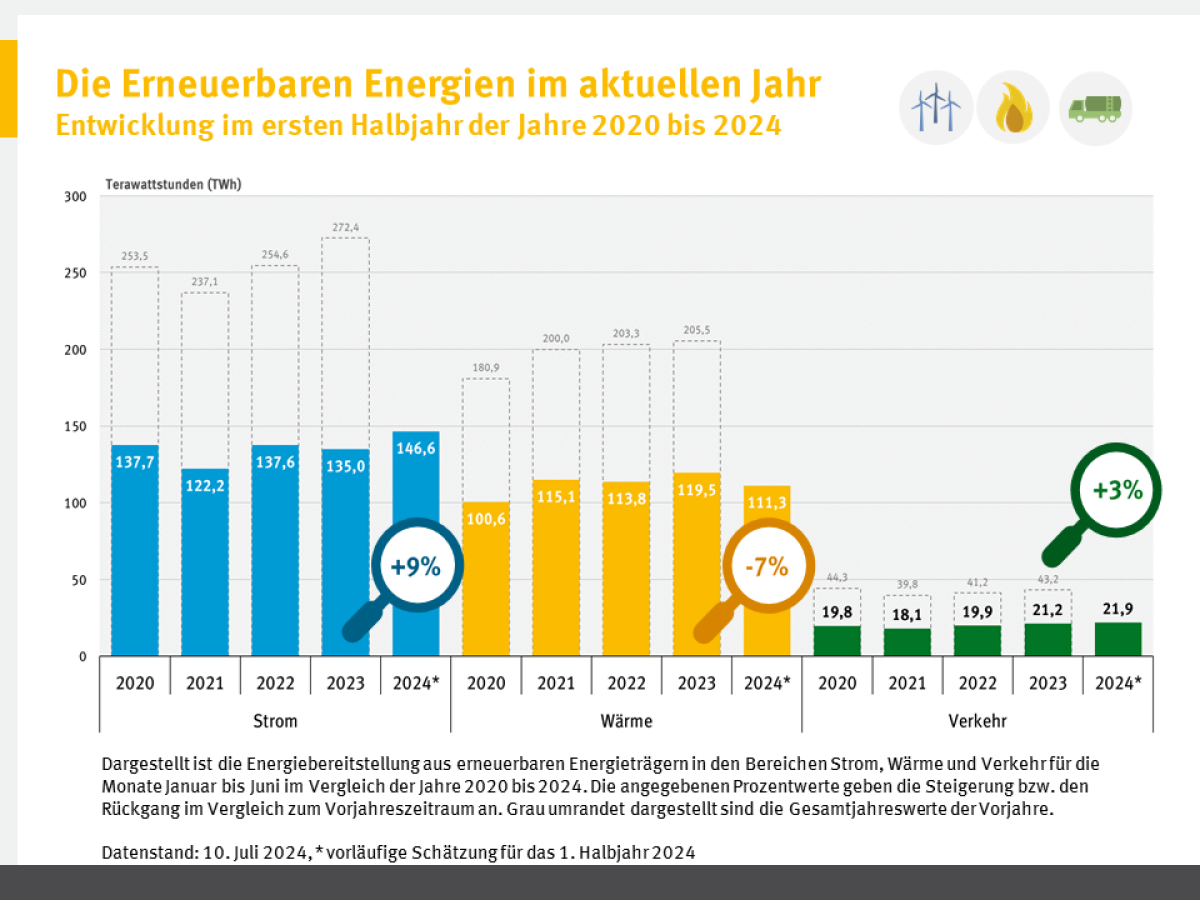"It is a success that the renewable share of electricity continues to grow. At the same time, the growth figures make it clear that considerable efforts are still required. In the photovoltaic sector alone, we need an increase of around 50 per cent in order to meet the targets of the Renewable Energy Sources Act,” says Dirk Messner, President of the German Environment Agency. “Planning reliability and careful further development of the subsidy mechanisms are important for success. In addition, distribution grid areas in which a particularly large number of renewable energy systems are connected should not be burdened further by rising grid fees.”
Renewables account for around 57 per cent of gross electricity econsumption
Approximately 147 terawatt hours (TWh) of electricity were generated from renewable sources, representing an increase of about nine percent compared to the same period in the previous year (135 TWh). Two factors played a decisive role in this. Firstly, windy winter months and the addition of new plants led to a 10 per cent increase in wind power generation. In addition, the large increase in output in the photovoltaic (PV) sector led to an increase of 13 per cent compared to the same period of the previous year, despite the lack of sunshine. In the hydropower sector, rainy weather led to an increase of 12 per cent.
Over the entire first half of 2024, wind power generation accounted for the largest share of renewable electricity generation at around 51 per cent. Photovoltaics followed with 24 per cent, electricity generation from biomass with around 15 per cent and hydropower with around 8 per cent of renewable electricity.
As demand for electricity in the current year was roughly the same as in the previous year, the share of renewable energies in gross electricity consumption rose significantly in the first half of 2024. According to calculations by the Working Group on Renewable Energy Statistics (AGEE-Stat), the share was already around 57 per cent. A projection for the entirety of 2024 is not possible at this stage, as renewable electricity generation depends on weather conditions and the development of electricity consumption throughout the rest of the year.
The increase in output in the first half of 2024 was once again heavily dominated by the expansion of PV. For example, net additions in the first two quarters totalled 7.5 gigawatts (GW), while the addition of onshore wind energy systems only reached 0.9 GW. Around 0.4 GW of net new capacity was added to the installed capacity of offshore wind energy plants in the second quarter. With total installed capacity exceeding 88 GW, the 2024 expansion target for PV of 84 GW, as set by the German Renewable Energy Sources Act (EEG), has been achieved six months ahead of schedule. The installed capacity of onshore wind turbines currently stands at just under 62 GW, which means that the target of 69 GW set by the EEG in 2024 is unlikely to be reached
Decline in renewable heat production
Total heat production from renewable sources amounted to 111 TWh in the first half of 2024. Compared to the first half of 2023, the heat provided from renewable sources fell by seven per cent overall. The main reason for this was warmer weather than in the same period of the previous year, which reduced the overall demand for heat.
This decline was mitigated by an increase in the number of heat pumps. As a result of this dynamic growth in heat pumps, particularly as a result of installations in the second half of 2023, around 3.5 per cent more heat was generated from near-surface geothermal energy and environmental heat compared to the same period last year.
However according to the latest reports from industry associations, sales of heat pumps have fallen sharply by around 50 per cent compared to the previous year. In order to achieve the German government’s target of 500,000 installed heat pumps per year, this trend needs to be reversed. Three quarters of renewable heat still comes from biomass, around 6 per cent from biogenic waste and around 4 per cent from solar thermal systems.
Slight increase in the transport sector
In the first half of the year, around 21.9 TWh from renewable sources was used in the transport sector. This is an increase of 3 per cent compared to the first half of 2023. Based on current information, the total amount of biofuels used was at the same level as in the first half of the previous year. In contrast, the use of renewable electricity in the transport sector increased by 16 per cent, as not only did the renewable share in the electricity sector grow, but so did the number of electrically powered vehicles. The amount of renewable electricity used in the transport sector corresponds to just under three per cent of the green electricity used in Germany. Around 70 per cent of this is used in rail transport and today around 30 per cent in road transport.
Further information:
The Working Group on Renewable Energy Statistics (AGEE-Stat) analyses the use of renewable energies on behalf of the Federal Ministry for Economic Affairs and Climate Action (BMWK) and continuously compiles reports on the development of renewable energies on the basis of currently available data. In addition to annual publications, AGEE-Stat also regularly publishes monthly and quarterly reports. In the current quarterly report, you will find further graphics on the current development of renewable energies in 2024. The AGEE-Stat head office is located at the German Environment Agency in Dessau.
 Click to enlarge
Click to enlarge

